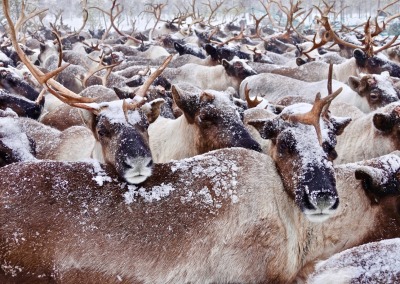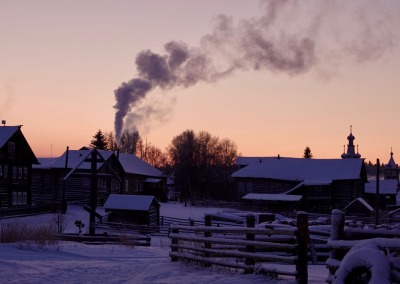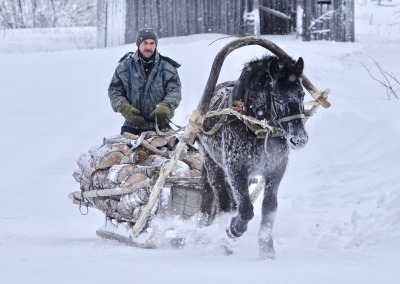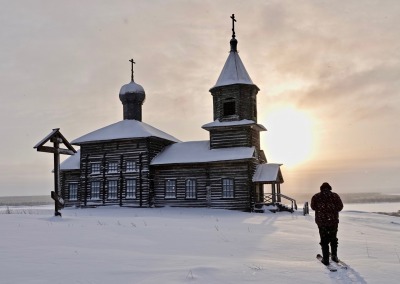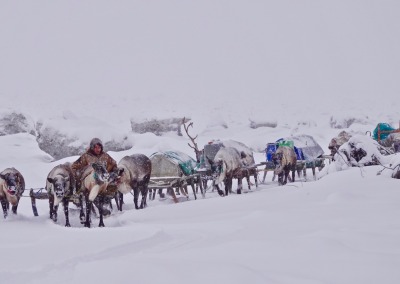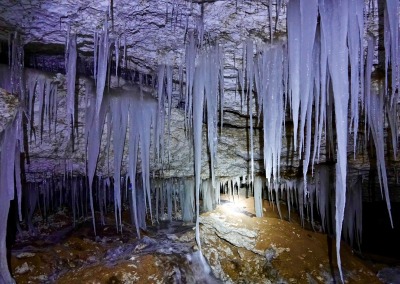Archangel Province: Nenets nomads and Pomor villages
Tour Overview
Highlights
- Living with a family of nomadic Nenets reindeer herders from the Kanin Peninsula
- Exploring traditional Pomor villages like Kimzha, Lampozhnya and Dolgoshchelye
- Visiting traditional wooden churches in Kimzha, Zaozerye and Bolshaya Nisogora
- Seeing the Northern Lights if you are lucky
- Reindeer sledding with the Nenets
- Horse sledding with the Pomors
- Dog sledding from a husky farm near Archangel city
- Exploring the labyrinthine underground cave system of Pinega District
- Enjoying winter wonderland scenery, karst canyons, unfreezing waterfalls and more
- Finishing with a drive through the snowy taiga forest of the Komi Republic
Itinerary
Day 1: Dog sledding
Fly into Archangel (Arkhangelsk). Drive one hour to a husky breeding farm. Meet the dogs and go for a 3km sled ride through the forest and over the surface of a frozen lake. Afterwards, continue to Golubino village in Pinega District. Overnight in hotel. This transfer can also be made into a 2-day 120km cross-country dog sledding expedition at extra cost. Please get in contact for details.
Day 2: Exploring Pinega District
This whole area is built on labyrinths of caves. Today we explore the underground cave networks, full of ice stalagmites and stalactites. We also go for hikes through the spectacular forest and karst scenery of Pinega District, visit an unfreezing waterfall, karst gorges and an abandoned monastery on a hill with spectacular views over the River Pinega. Overnight in Golubino.
Day 3: Pomor villages
Travel on to Mezen District, the final frontier of Archangel Province before Nenets territory begins. Visit the beautiful Pomor village of Kimzha, whose centrepiece is a huge 18th-century wooden church. There are also many traditional Pomor houses over 100 years old, two traditional wooden windmills and a traditional “crane” well. After Kimzha we head on to Lampozhnya village, situated on an island and usually inaccessible by car. For centuries, the Lampozhnya island was the site of an annual winter fair at which the Pomors traded with the Nenets. Traders even came from as far away as Britain.
Horse sled taxis come to meet us outside the village and take us the last few kilometres. After a late lunch we explore the village, meet the locals and visit the local horse breeders. Overnight in a simple guest house.
Day 4: To the Nenets
Drive by car to Mezen town. Although it is called a “town” and is the district centre, it has a population of only 3,000 and is built almost entirely of wood. Here we meet our Nenets hosts and travel with them on sledges attached to the backs of their snowmobiles until we reach their nomadic encampment.
These Nenets are from the Kanin Peninsula, the westernmost extent of Nenets territory. In late January, they migrate southwest off the peninsula and into the forest tundra of Mezen District. They stay there without migrating until mid-April, when they start moving back north towards the Kanin Peninsula. If you visit them in late January or mid-April, you have a good chance of joining them on their migration. A particularly spectacular event to witness is their crossing of the River Mezen. They do this quite near its mouth on the White Sea, so it is about 5 km wide and covered in ice hummocks often taller than a person. Seeing the sledge caravans and thousands of reindeer threading their way between these ice hummocks is an unforgettable sight.
Please note: unlike the Nenets of the Yamal Peninsula, the Kanin Peninsula Nenets do not live in chums (reindeer-fur teepees). Instead, they live in large home-made tents: thick sheets of canvas on a wooden frame.
Overnight in a tent with a Nenets family.
Day 5: Live with the Nenets
Immerse ourselves in the daily life of the camp, whether that be migrating, herding reindeer, cutting trees for firewood, collecting snow and ice for water, etc.
Day 6: Return to Mezen
Return to Mezen in the evening, possibly via Dolgoshchelye or Kamenka villages, depending on exactly where the Nenets are camped when we visit. Overnight in hotel.
Day 7: Drive to Leshukonskoye
Drive south to Leshukonskoye village. On the way, we pass many quaint and remote villages with wooden churches, “crane” wells, windmills, traditional houses and spectacular views over the River Mezen. In many of them you still see people using horse sleds for transport. Overnight in guest house in Leshukonskoye.
Day 8: Leshukonskoye District
Walking tour of Leshukonskoye. Unlike Mezen District, which has very low river banks, Leshukonskoye is set on very high banks above the River Mezen and as such has some spectacular view points. It also has a very quaint wooden chapel in the village graveyard.
After exploring Leshukonskoye, we drive to Zaozerye village to visit the spectacular wooden church and bell tower, which we will climb for views of the village. We will then drive to the very remote Bolshaya Nisogora village. Bolshaya Nisogora also has a beautiful wooden church spectacularly situated on high banks above the River Mezen.
Overnight in guest house in Leshukonskoye.
Day 9: To the Komi Republic
Drive south through dense taiga forest and cross the border between Archangel Province and the Komi Republic, which is inhabited by the indigenous Komi people, who have their own language. Pass lots of isolated villages with wooden houses, chapels, wells and horse sledges. In the evening we arrive in Usogorsk town and take an overnight train to Syktyvkar, capital of the Komi Republic.
Day 10: Fly home
Upon arrival in Syktyvkar, we transfer from the train station to the airport and fly home.
Tour price
Number of people: {{ currentPerson }}
Price per person: $ {{parseFloat(price).toFixed(0)}}
Price includes:
- All transport in comfortable private vehicles
- Accommodation in Golubino in twin ensuite rooms. Elsewhere in simple guest houses.
- Snowmobiles to reach the nomad camp with drivers, petrol, all drivers’ expenses and attached walled box sledges for clients to ride in
- All activities including dog, reindeer and horse sledding
- English-speaking guide
- All meals
- All meals while with the nomads
- All permits required for the region
- Fees to the Nenets for hosting us
- Letter of invitation for 30-day Russian tourist visa
- Satellite phone for emergency calls
Price does not include:
- Transfers, accommodation, food or guiding in Moscow. This can be added at extra cost if so desired
- Flights to Arkhangelsk or from Syktyvkar. These can be added at extra cost if so desired
- Personal travel insurance or medical insurance
- Personal expenses
- Clothing or equipment. This can be rented from us if required
- Satellite phone for personal or work-related calls. You can purchase minutes for $2 per minute

